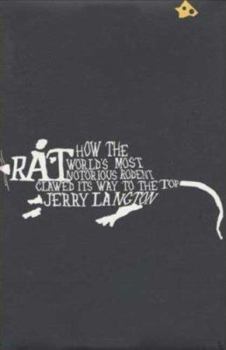Rat: How the World's Most Notorious Rodent Clawed Its Way to the Top
Select Format
Select Condition 
Book Overview
From its origins in the swamps of Southeast Asia to its role in the medieval Black Death to its unshakeable niche in modern urban centers, the rat has incredible evolutionary advantages. Combining... This description may be from another edition of this product.
Format:Hardcover
Language:English
ISBN:0312363842
ISBN13:9780312363840
Release Date:June 2007
Publisher:St. Martin's Press
Length:207 Pages
Weight:0.75 lbs.
Dimensions:0.8" x 6.6" x 8.5"
Customer Reviews
4 ratings
Another book on rats that can't help having editorial content . .
Published by Thriftbooks.com User , 15 years ago
I loved seeing a general book about rats like this one. But I'd have loved even more sucha book written by someone who has actually had and loved a pet rat. I know that wild rats and humans are eternally at war, but the comments made about pet rat owners were a bit off-putting. Otherwise this was a good book about the critters both wild and domesticated. I learned a lot about all rats including the ones I used to kill in our barn as a kid and the ones I actually pay money to a vet to keep alive.
Rat
Published by Thriftbooks.com User , 16 years ago
This book was extremely informative, interesting and entertaining; however, it's only 204 pages long and I found 8 typographical errors. Wow. Who drops the ball in a situation like this? Is our society forgiving of errors, ignorant of grammatical rules (some of the errors could have been categorized as such), or simply skimming material? I still liked the book.
Interesting and Easy Read!
Published by Thriftbooks.com User , 16 years ago
Rats reproduce prolifically - it's possible for a three-year-old rat to have given birth to 43 litters, up to 516 little ones. The adaptation that has helped rats the most has been their ability to live with humans - in fact, they seek us out. They can barely see beyond four feet (though visually detect motion up to 50 feet), and are close to color-blind. They can detect and differentiate smells as well as the best of dogs, can detect sounds about 2.5X better than humans, detect different tastes as small as 0.5 ppm (equivalent to about 2 grains of salt in a pound of peanut butter). When a rat senses something isn't right with a food source, it will urinate on it - making poisoning more difficult. They stay close to walls, can leap four feet from a standing position and climb brick walls or lead pipes. Rats are also excellent swimmers and can squeeze through holes only 3/4" in diameter. About 10-100% of pet rats and 50-100% of wild ones carry rat-bite fever virus - fatal 13% of the time to humans. Rats also have a taste for electrical insulation - it is estimated that 25% of non-arson fires are caused by rats. Plague is that rat's most famous "contribution." An estimated 75 million humans have died in as many as 100 different plagues. (My suspicion is that since each began with widespread rat deaths, multi-years' interval was required to rebuild the population and associated flea carriers.) The Great Fire of London (1665) brought the first steps towards controlling plague. After the fire rated for four days and destroyed 13,200-some homes, one reaction as to ban highly combustible thatch roofs within the city. Since thatched roofs are also an ideal habitat for black rats (they sleep in burrows in the thatching during the day, and rain urine and feces down upon the home's inhabitants), this substantially reduced their environment. Rebuilding also included wider streets and a modern sewage system. Plague frequency and intensity in London began dropping as these changes were implemented. In the late 1890s a Swiss medical student named Yersin realized that plague was connected to rats while in Asia investigating the plague there at the time. He noticed the connection between large rat die-offs prior to humans getting the plague (we are the fleas' second-choice), and that those tasked with sweeping out dead rats were the first to become infected. This led to deliberate steps to reduce rat infestations, and later, steps to control fleas (easier than killing rats). The last major plague outbreak was in Chile and Argentina in 1945; we now average about 2,000 plague deaths/year. BUT, rats are developing resistance to the poisons used against them, so . . . "Rats" was interesting and an easy read; my only criticism is that its data were sometimes inconsistent.
Rats!
Published by Thriftbooks.com User , 16 years ago
Intelligent, adaptable, prolific, omnivorous, destructive: in Jerry Langton's book, this description applies not only to people, but to the common brown and black rats that share our habitat. Langton, a Canadian freelance writer, provides a stroll through rat history and lore, from "Ben" to bubonic plague, and a close-up and personal encounter in the sewers. A major topic of the author is why these rodents are so difficult to get rid of, and why most of us want to (no Rat Fancier, he). His basic conclusion is that rats are so well adapted to the human-created environment (our garbage, our graneries, our cities, farms, and sewers) that it is very likely they will be with us always, in spite of all our poisons and traps. This is a short and interesting book, that will introduce the general reader to an animal to which most of us have an instinctive aversion, without really knowing much about them.





